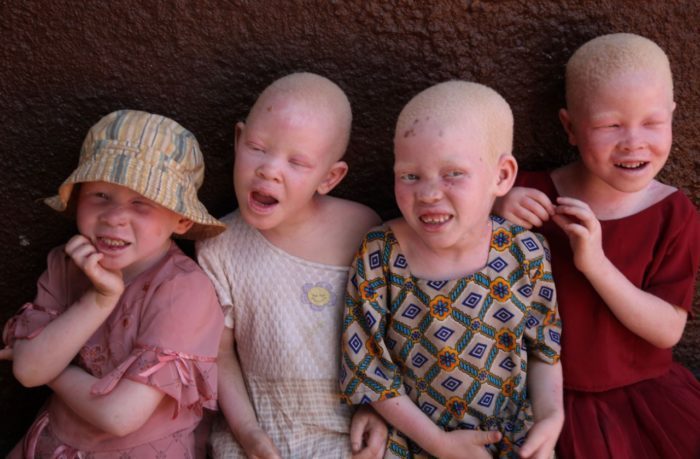Albinism: Facts, Social And Health Issues And What You Need To Know About The Condition

Albinism is a rare group of genetic disorders that cause the skin, hair, or eyes to have little or no color. The condition involves a group of inherited conditions. People affected by albinism have little to no pigmentation in their hair, eyes, or skin and have inherited genes that have been altered and do not produce the average amounts of a coloring pigment known as, ‘melanin.’
The prevalence of albinism in Nigeria is ranked among the highest in the world with an estimated figure of two million albinos in the country according to a publication from the Department of Medicine, University Teaching Hospital, Benin. The majority of children with albinism are born to parents who have average eye and hair color for their ethnicity. At times, people are not aware they do have a form of albinism.
Presentation of Albinism
Not everyone with albinism has light hair and skin; although most do. ‘Oculocutaneous,’ albinism or, ‘OCA,’ involves the person’s hair, eyes, and skin. ‘Ocular albinism,’ or, ‘OA,’ is far less common and mostly involves the person’s eyes; their hair and skin might appear either similar or somewhat lighter than that of their family members. Researchers have used different systems to classify albinism through the years.
Overall, the systems used to classify contrasted forms of albinism range from those who have a near lack of pigmentation to those who have slight pigmentation.
People with less pigmentation have skin and hair that are cream-colored and their vision is many times in the range of 20/200. People with albinism who have slight pigmentation have hair that appears red-tinged or yellow; they may have better vision as well. Recent research uses DNA analysis to reach a more precise classification system for albinism. There are now four recognized forms of albinism: OCA1, OCA2, OCA3, and OCA4 – as well as division into further subtypes.
Albinism and Vision Problems
People who have albinism always experience vision issues; a number of them have low vision. The degree to which a person with albinism experiences a vision impairment varies with the form of albinism they have.
A portion of the population with albinism are legally blind, although they still have the ability to read and do not use Braille. Some people with albinism see well enough to drive.
Vision issues related to the disability are the result of exceptional development of the person’s retina, as well as exceptional patterns of nerve connections between their eye and their brain. Due to this fact, the primary test for albinism is a simple eye examination.
Albinism and Vision Rehabilitation
Eye problems people with albinism experience are the result of exceptional development of their eye due to lack of pigmentation and many times include the following:
- Astigmatism
- Far-sighted or near-sightedness
- An iris with little to no pigmentation
- Photophobia, or sensitivity to bright light and glare
- Nystagmus, or regular horizontal back and forth movement of the eyes
- Foveal hypoplasia, where the retina, does not develop as usual prior to birth and during infancy
- Strabismus, or muscle imbalance of the eyes ( ‘crossed eyes’,’lazy eye’) or an eye that deviates outward
- Optic nerve mis-routing, where the nerve signals from the retina to the brain do not follow the usual nerve routes
Treatment of eye conditions related to albinism is comprised of visual rehabilitation. Surgical intervention might improve the appearance of the person’s eyes, but it will not correct the mis-routing of the nerves from the person’s eyes to their brain.
Surgery also will not improve the person’s eyesight, or their fine binocular vision. When a person with albinism has estropia, or crossed-eyes, surgery might improve their vision through expansion of the area the person’s eyes can see as they look at one point, according to expert opinions. Help may also include prescription glasses.
Social And Health Issues Associated With Albinism
There is potential for social stigmatization to happen, particularly when the race or paternity of a person with albinism might be questioned. A result of this can be isolation.
Families and schools need to make efforts to ensure that children with albinism are not excluded from group activities
The majority of people who have albinism have fair complexions; yet a person’s hair or skin color is not sufficient to diagnose a person with albinism. People who do have albinism need to be careful to avoid sun damage to their skin. Wearing hats, sun-protective clothing, and sunscreen lotions is important.
People with albinism who do not use appropriate skin protection have the potential to develop life-threatening forms of skin cancers.


